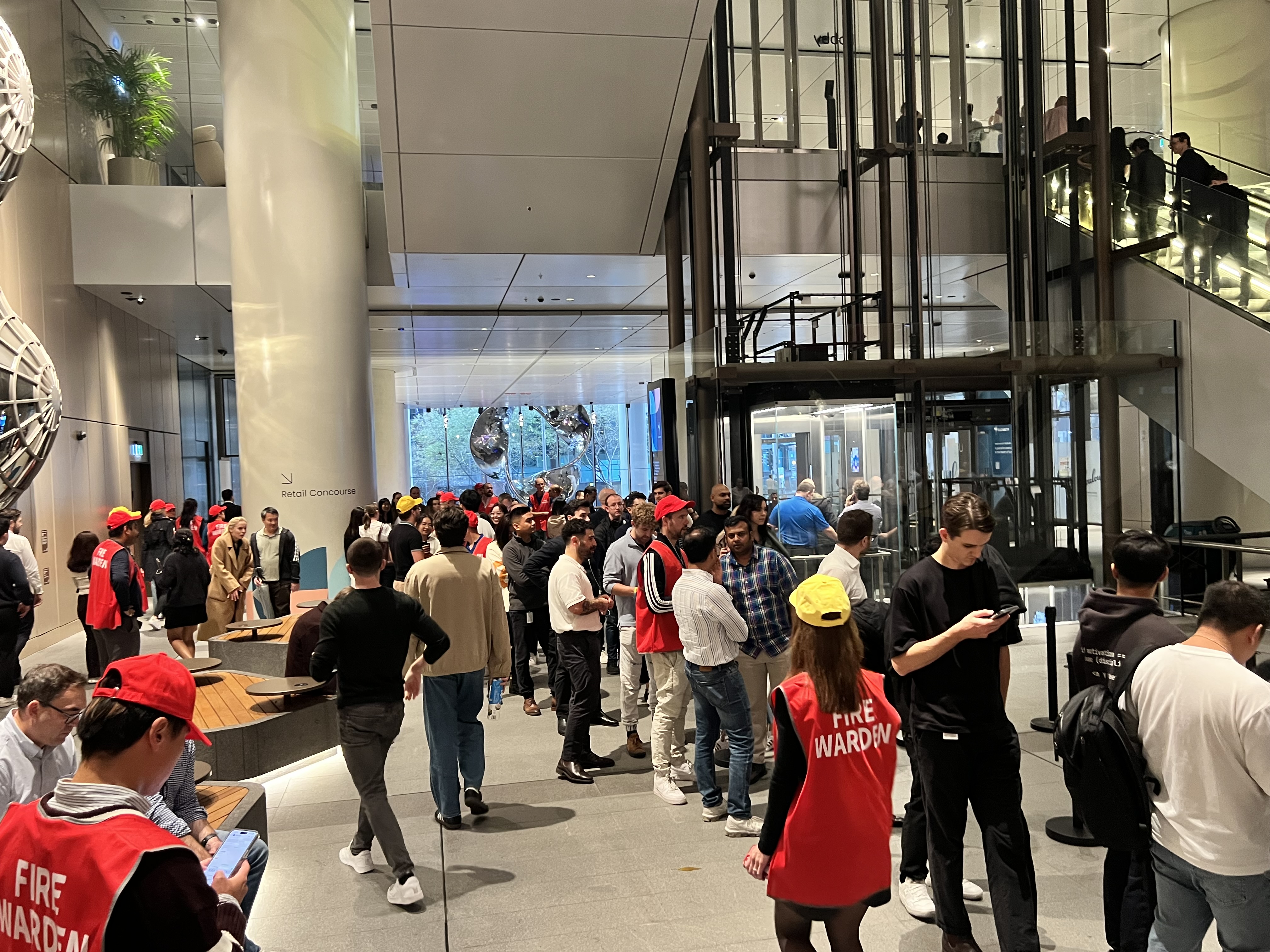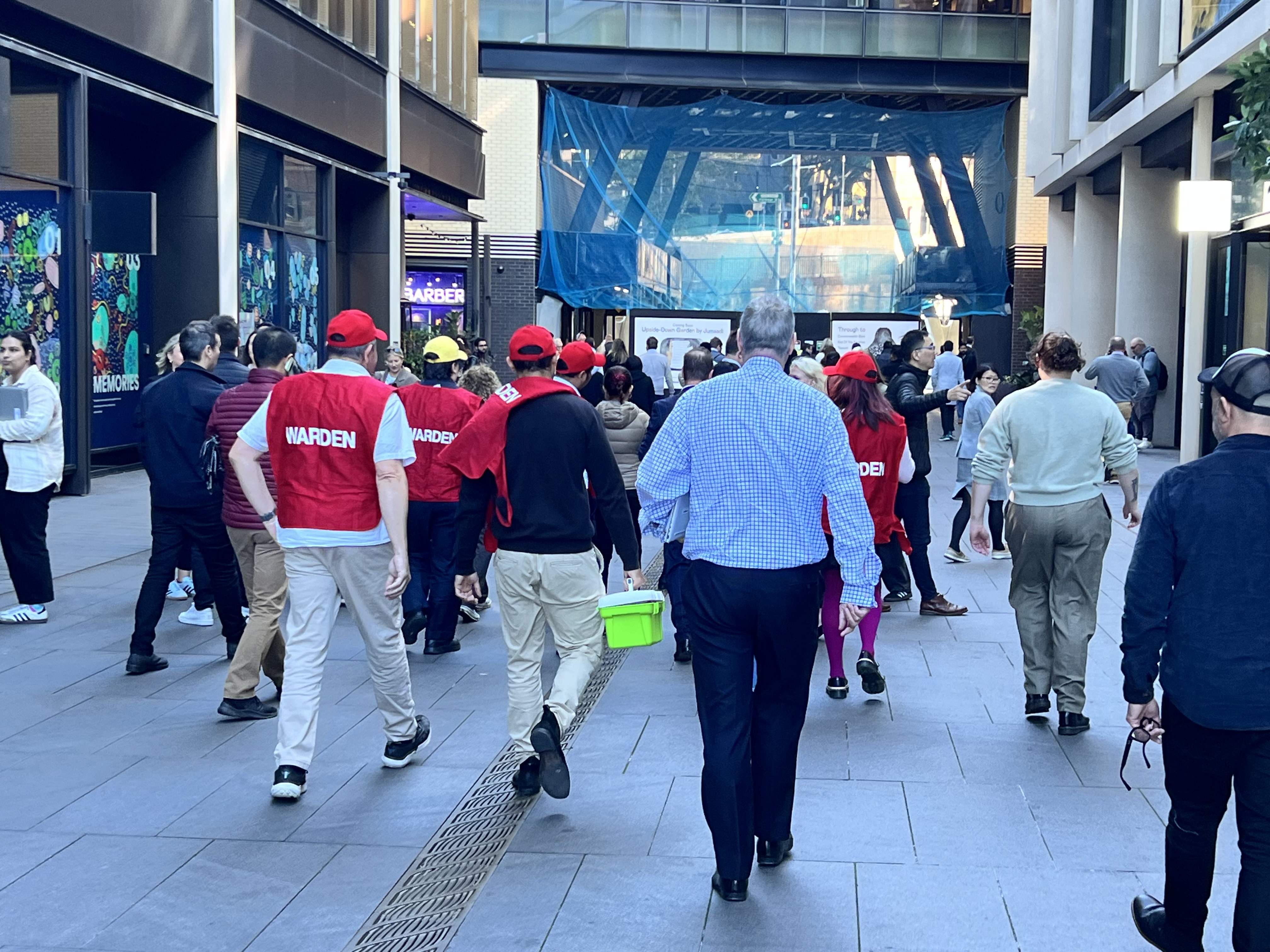
Warden Training In Commercial Building Evacuation: Insight from Australia’s Business Districts
Behind every safe evacuation is a trained warden – discover how Emcorp builds that confidence.

When a fire alarm goes off in a high-rise, it’s not theory – it’s hundreds of people on the move, stairwells filling, radios crackling and wardens making calls in real time.
That’s why training matters, the kind that builds calm, capable people who know exactly what to do.
Across Australia, commercial fire and emergency training is under more scrutiny than ever. With growing urban density, tighter compliance requirements and the reality of large-scale incidents, organisations are expected to demonstrate proven capability in practice. Aged care facilities need staff who can move vulnerable residents safely. Retail complexes must coordinate thousands of shoppers. Industrial sites face chemical and equipment hazards. Every sector faces unique challenges, but all share one truth: effective emergency training saves lives.
Recently, Emcorp Group’s risk services team delivered a warden training program inside a 30-plus storey tower in one of Australia’s busiest CBD precincts. Wardens from major tenants across multiple levels came together for evacuation drills, scenario testing and the kind of hard questions that only surface when people see how an emergency actually plays out.
The reality of high-rise evacuation
Evacuating a high-rise is nothing like filing out of a suburban office block. You’re moving thousands of people through fire stairs that weren’t designed for comfort, keeping communication clear across dozens of floors and guiding everyone to an assembly point that’s often already packed with city foot traffic.
These challenges aren’t unique to commercial towers. Aged care fire and emergency training needs to account for residents who can’t descend stairs quickly. Retail fire and emergency training must deal with shoppers unfamiliar with exits. Industrial fire and emergency training often means high-risk machinery or hazardous substances left mid-operation. The environments differ, but the core principles of warden training, emergency planning and compliance with AS 3745 remain consistent.
Our training program was designed to confront these challenges head-on. We went beyond theory to support wardens in their actual workplace – learning by doing.

What the training covered
On the alarm
Wardens drilled the basics: what happens when the fire indicator panel activates, what the alert and evacuation tones mean, and how to make immediate calls that align with Emergency Control Organisation (ECO) procedures. Seconds matter. Wardens learned to act without hesitation, ensuring the rest of the building can follow.
Managing people
The hardest part of evacuation is naturally the people part. In every drill, human behaviour sets the pace. Someone freezes on level 27. A visitor doesn’t know where the stairs are. A contractor wants to grab equipment before leaving. Wardens practiced steadying nerves, preventing stairwell bottlenecks, assisting mobility-impaired colleagues through Personal Emergency Evacuation Plans (PEEPs) and staying accountable for everyone in their care. This is where leadership shows.
Fire stair flow
Thirty storeys of people is a lot of feet on a lot of stairs. Without strategy, movement grinds to a halt. Wardens tested methods to keep the descent steady, merge groups from different levels smoothly and use radios to update the Chief Warden if conditions changed. If a stairwell became blocked or overcrowded, the team needed a plan B – fast.
Communication across levels
Clear reporting saves time and lives. Wardens trained with two-way communication systems and direct reporting protocols to provide live updates: which levels were clear, which weren’t and whether medical assistance was needed. The Chief Warden can only make smart decisions if they have accurate information.
Assembly area management
The evacuation doesn’t end at the door. At the assembly point, wardens conducted headcounts, flagged missing persons and kept groups together until emergency services gave the all-clear. In a CBD environment, this means managing staff in crowded spaces, staying visible and preventing drift.
First aid and CPR integration
Fire and emergency training doesn’t stop at evacuation. Wardens also reviewed the basics of first aid and CPR training, so they could step in immediately if someone collapsed during the evacuation. Quick response in those moments can mean the difference between recovery and tragedy.
More than fire drills
The program also looked at scenarios beyond fire. Modern workplaces demand training for a wider range of emergencies.
- Shelter-in-place: Wardens practiced securing people indoors during external threats like hazardous materials, smoke events or civil unrest. This included sealing procedures, communication protocols and keeping occupants safe until the hazard passed.
- Lockdown: With rising concern about hostile intruders, wardens trained in lockdown procedures. That meant communication strategies, identifying safe zones in open-plan offices and securing spaces until authorities arrived.
These scenarios reflect a shift from purely fire-focused drills to full-spectrum emergency and security management.

Why it matters
Standards such as AS 3745, AS 4083 and AS 1851 require organisations to establish, train and maintain ECOs. But compliance is the floor, not the ceiling. The real payoff comes in resilience.
- Compliance assurance: Proving that wardens are trained to standard.
- Practical readiness: Wardens confident under pressure, not just in theory.
- Business continuity: Minimising disruption through rapid, organised response.
- Duty of care: Meeting obligations to staff, contractors and visitors.
- Reputation protection: Avoiding headlines no company wants – “Evacuation chaos as firm unprepared.” Not a good look.
Risk management and crisis management aren’t abstract. They’re tested in moments of noise, fear and confusion. That’s when good training proves its worth.
Lessons from the case study
- Engagement counts: Wardens brought insights from their own workplaces, enriching the session. One tenant realised their internal contractor process needed updating after the drill.
- Real-world context sticks: practicing in the actual tower gave participants a clear mental picture of how scenarios would unfold.
- Communication is non-negotiable: Structured reporting kept things on track, even when drills got messy.
- Training must evolve: Fire remains the core, but threats now include hostile intruders, hazardous materials and power outages. Training must move with the risks.

Emcorp’s approach
At Emcorp Group, fire and emergency training is never a tick-box exercise. We deliver integrated programs across commercial, aged care, retail and industrial sectors. That means risk assessments, emergency plans, evacuation diagrams, warden training, evacuation drills, first aid training, CPR training and scenario testing.
Our programs are built to align with standards like AS 3745, AS 4083 and AS 1851, but also tailored to the realities of each workplace. A high-rise evacuation is different from an aged care evacuation. A retail lockdown looks nothing like an industrial hazardous materials incident. We design training that reflects these differences while keeping the workforce grounded in universal principles of safety management and compliance.
Security management and safety management are truly integrated. We make sure wardens, management teams and staff understand not just what to do but why it matters. That knowledge builds confidence, which translates into safer, more resilient workplaces.
Building resilience, one warden at a time
A high-rise evacuation is never neat. But with trained wardens, it’s controlled. Calm. Safe.
That’s the difference between a plan on paper and a workforce ready to act.
By investing in professional fire and emergency training, organisations strengthen compliance, protect people and safeguard business continuity. And when the alarm sounds – whether in a 30-storey tower, a retail centre, an aged care home or an industrial site – that preparation makes all the difference.
Every organisation is different. Let’s build a strategy that fits yours.
From site-based training to enterprise-wide planning, we tailor our approach to your needs.
